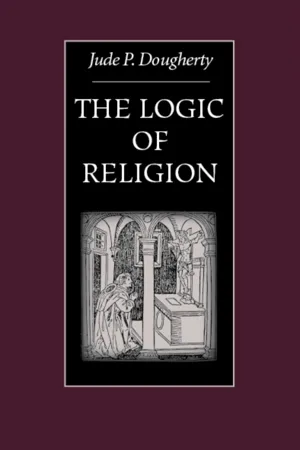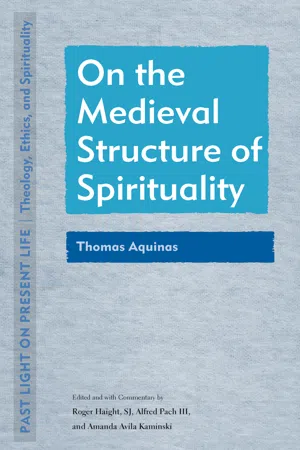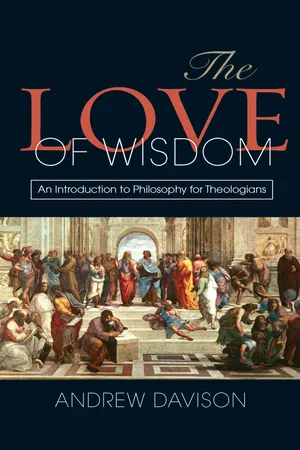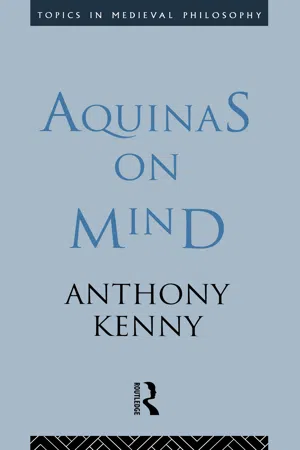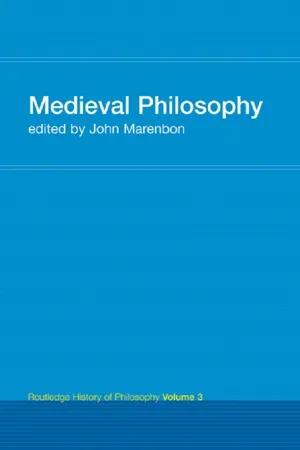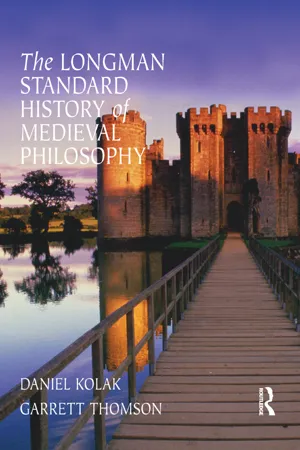History
Thomas Aquinas
Thomas Aquinas was a prominent medieval philosopher and theologian known for his synthesis of Christian theology with Aristotelian philosophy. His most famous work, "Summa Theologica," sought to reconcile faith and reason, shaping the development of Western thought. Aquinas' emphasis on natural law and the compatibility of faith and reason had a profound impact on the fields of philosophy, theology, and ethics.
Written by Perlego with AI-assistance
Related key terms
Related key terms
1 of 4
Related key terms
1 of 3
11 Key excerpts on "Thomas Aquinas"
- eBook - ePub
- Jude P. Dougherty(Author)
- 2010(Publication Date)
- The Catholic University of America Press(Publisher)
IV
THE RELATION OF FAITH TO REASON IN AQUINAS AND THE REFORMERS
Aquinas, Luther, CalvinSt. Thomas Aquinas (1224–74) is regarded as the greatest of medieval theologians, and the study of his philosophy has been recommended by every pope since his death. It was specifically endorsed by Leo XIII in his encyclical Aeternae Patris (1879), which enjoined the Catholic world to study Thomas as an antidote to the secular and atheistic philosophies of his day. Thomas is studied by both theologians and philosophers. His commentaries on the works of Aristotle remain among the most authoritative ever written.Thomas brought to his study of the Catholic faith not only Plato, the Neoplatonists, the Stoics, and the teachings utilized by Augustine but Augustine himself, whom he quotes more than any other philosopher. In addition to those sources, he had access to important works of Aristotle unavailable to his Latin predecessors. His Summa Theologiae, written as a handbook for contemporary use, begins by setting out what can be known of God by natural reason and then develops that knowledge with the aid of Sacred Scripture into a theological masterpiece that has been studied in every generation since. The relation of reason to faith is clearly explicated in a manner that serves as a benchmark for many contemporary studies. Our interest in Thomas is not merely antiquarian. He provides for the modern reader a viable understanding of the nature of religion that can take its place among contemporary treatises.St. Thomas does not have a self-contained or explicit treatise on the subject of religion. Nevertheless, to anyone familiar with his writing, it is evident that his work not only presupposes a theory of religion but articulates one on a piecemeal basis within the context of other discussions. To put the pieces together is to have a philosophy of religion which can speak to numerous issues raised within the discipline as it is practiced today. This is not to say that Thomas has anticipated every contemporary concern. There are obviously many issues he did not address, some provided by the history of Western religion and some resulting from precisions in philosophy itself. Thomas, as any other medieval, modern, or contemporary thinker, might be open to the charge of limited acquaintance with religion globally considered. An examination of the source material available to Thomas would disclose that he was aware of the religious outlook of the Hebrews and that he knew something of Islamic creeds and practices. He was not aware of the tribal religions in Africa or of the major religions of Asia.1 - eBook - ePub
On the Medieval Structure of Spirituality
Thomas Aquinas
- Roger Haight, Alfred Pach, Amanda Avila Kaminski(Authors)
- 2022(Publication Date)
- Fordham University Press(Publisher)
As a consequence, this introduction follows a somewhat serpentine route to the texts presented in this volume. We begin with the renaissance in the High Middle Ages in Europe, the formation of the universities, and the jolt that the discovery of Aristotle gave to intellectual life. Thomas Aquinas is the child and a leading mediator of the transitions of this period. Understanding his work requires close attention to the new methods of learning that were occurring in the thirteenth century and the intellectual language that Aristotle provided. He introduced some basic ideas and terms that governed a more critical way of thinking. Only then can we turn to a brief explanation of the subject matter of these texts: Thomas’s theology of grace, the nature and role of virtues in human life, and the idea of natural law that became so closely associated with Catholic spirituality. It should be clear that what Aquinas represents in these writings is a foundational map, a metaphysics, of the Christian life.Europe, the University, and Aristotle
Thomas Aquinas wrote a massive synthesis that organized a Christian self-understanding into a genuine worldview. It became a standard for the theology of the schools. Some of its basic ideas live on and are taken for granted. But they first surfaced in a world as different from our own as Aquinas’s was from Augustine’s. The new Medieval culture cannot be represented in a few pages, but it has to be acknowledged; and the elementary concepts of the new Aristotelian language have to be described. In lieu of a history of Western Europe, what follows points to the economic, social, and cultural dynamisms of the eleventh and twelfth centuries, the new position of the church in Western Europe, and the influence of the university and Aristotle on theology during the thirteenth century.2Europe and the church. - eBook - ePub
- Michael Reeves(Author)
- 2012(Publication Date)
- IVP(Publisher)
Aristotle soon divided the academic world: some seemed to swallow him whole; others saw worrying issues, such as his view that the world had always existed, and decried Christian use of the pagan Aristotle as the sin of Rachel, who smuggled her father’s idols under her skirt. How to treat Aristotle became the cause célèbre. Then Thomas Aquinas proposed a system in which he sought to bring Aristotelianism into Christianity in a way that preserved the integrity of both. It would be a Christian Aristotelianism.The result was triumphant: his masterpiece, the Summa Theologiae , became the standard textbook of Roman Catholic theology and was said to have been laid alongside the Scriptures on the altar at the Council of Trent, where he was given the title ‘Universal Doctor of the Church’; he was hailed by popes as the ‘defender of the Catholic Church and conqueror of heretics’; in 1998 Pope John Paul II issued an encyclical in which he described ‘the Angelic Doctor’ as ‘a model of the right way to do theology’. And his influence has not been confined to Roman Catholicism: even deep in Reformed circles, Aquinas is happily regarded by many as a major influence.Aquinas’ life
Tommaso d’Aquino was born at some point between 1224 and 1226 in his family castle of Roccasecca, between Rome and Naples. The castle is the giveaway that Thomas came from noble stock. He was, however, the youngest son, and so dealt with in the traditional manner: aged five he was handed over to be educated at the nearby great Benedictine abbey of Monte Cassino, where he soon became known for his repeated question ‘What is God?’After a few years, fighting in the area persuaded his family to transfer him to the new University of Naples, and it was there that he was introduced to two of the great future influences on his life. The first was Aristotle, who elsewhere in Christian Europe was quite unknown (and whose writings were actually banned in Paris). The second was the Order of Preachers (‘Dominicans’), an order recently established by Dominic Guzman to combat heresy. Given their intent, the Dominicans gave study an especially high priority, which appealed to Thomas; they were also mendicant friars rather than monks (instead of detaching themselves from the world in a monastery, they lived by begging). Impressed, Thomas soon joined them, and thus entered the Dominican life of study – not study so much for the sake of monastic contemplation like Anselm, but study for the sake of teaching, and specifically university teaching in Thomas’ case. - Christian Nikolaus Braun(Author)
- 2023(Publication Date)
- Georgetown University Press(Publisher)
11Having provided a very brief overview of Aquinas’s historical significance, the next question is, who exactly was this man whose thought has had such a profound impact on Western thinking? Aquinas was born around 1225 at Roccasecca in southern Italy.12 His family was of minor nobility, and his father was related to and a vassal of Holy Roman Emperor Frederick II (1194–1250). As was a common practice at the time, Thomas was offered to the service of the Church because he was the youngest son of a large family. Between the ages of five or six he was sent to the prestigious Benedictine monastery of Monte Cassino. His family was said to hope that one day he would become the abbot. At Monte Cassino Thomas received his first education, including training in the thought of Augustine, which as the following chapters illustrate would greatly influence his thinking about war. However, Aquinas’s time with the Benedictines had to be cut short due to the conflict between Pope Gregory IX (1170–1241) and Emperor Frederick II. This conflict also affected the Aquino family more directly, partly because of switching allegiances. Consider, for example, the life of Thomas’s eldest brother Aimo. Aimo joined an expedition to the Holy Land in the service of Frederick II but was imprisoned by a vassal of the king of Cyprus. It was the pope who ransomed him, and Aimo would remain loyal to the papacy for the rest of his life. The life of Rinaldo, another of Thomas’s brothers, tells an even more dramatic story. Rinaldo was initially loyal to Frederick II but switched allegiance to Innocent IV (?–1254) when the pope deposed the emperor in 1245. In 1246 Rinaldo was executed by Frederick II for having betrayed his loyalty. Crucially, the Aquino family considered Rinaldo a martyr who had died for the Church.13 Jean-Pierre Torrell argues that the Aquino family history of having been drawn into the conflict between the emperor and the pope partly influenced Thomas’s thinking about the distinction between spiritual and temporal power.14- Available until 19 Sep |Learn more
The Love of Wisdom
An Introduction to Philosophy for Theologians
- Andrew Davison(Author)
- 2013(Publication Date)
- SCM Press(Publisher)
Aristotle featured here almost in the guise of a natural scientist. His many works on aspects of the natural world struck a chord with a culture newly concerned, for instance, to decorate its churches with carvings of foliage. His exhaustive discussions of the processes of reason chimed with the intellectual culture into which it was introduced. More significant still for Aquinas was the combination of these two elements, and the sense that human knowledge is always bodily, sensual knowledge: knowing through the senses. Far from the body dragging us down, as the Albigensians thought, it is integral to what we are. Aristotle helped Christian theologians to think such thoughts. The business of knowing might in a sense be immaterial – a thought is not a physical thing – but for Aquinas human knowledge is embodied all the same. We only know anything, even about God, as far we are led by sensible things (ST I.12.12). Aquinas uses a word here, manuduci, which literally means ‘lead by the hand’ by sensible things. The Relation of Philosophy and Theology Aquinas lived a busy life, full of travelling and organization, including drawing up the curriculum for the Dominicans across Europe and composing new liturgy for the Pope. Despite all this activity, Aquinas’s writings unfold at a leisurely pace set by the subject matter in hand and a spirit of contemplation. We mistake the man if we do not place prayer at the centre of his life. Near its end, during one of his long periods of prayer, the crucified Christ is said to have appeared to him and said ‘you have spoken well of me, Thomas’. Aquinas died at the monastery of Fossanova, east of Rome, in the modern province of Lazio, on 7 March 1274. When his canonization was later being considered, it emerged that the monks had not sung a requiem for him on the day of his death, as every convention would have dictated - Kevin H. Gary(Author)
- 2021(Publication Date)
- Bloomsbury Academic(Publisher)
CHAPTER FOUR Thomas Aquinas and EducationSTEIN M. WIVESTADA hymn written by Thomas Aquinas is used in churches all over the world during Holy Communion, often on Good Friday. The hymn ends with this verse:Jesu, quem velatum nunc aspicio, oro fiat illud quod tam sitio: Ut te revelata cernens facie, visu sim beatus tuae gloriae. O Christ, whom now beneath a veil we see, may what we thirst for soon our portion be. To gaze on thee unveiled, and see thy face, the vision of thy glory and thy grace.1Aquinas’ voice has influenced Christian worship and theology since the thirteenth century. He is considered by many to represent the Catholic intellectual tradition, but he stood against the theological and philosophical movements dominating his own age and would certainly have been against the modern individual liberalism of our age (MacIntyre 1998). The neo-Aristotelian turn in moral philosophy after 1980 created a new interest in Aquinas as an excellent interpreter and reformer of Aristotelian ethics. Aquinas modified the Aristotelian framework with God-centered discussions of moral and existential questions. Even agnostic philosophers have found Aquinas’ truth-seeking relevant (Kretzmann and Stump 1993).The study of Aquinas is demanding. His “writing has the uncanny ability to respond to our interrogation ‘by interrogating us’” (MacIntyre, cited in Overmyer 2013: 684). Aquinas was primarily a theologian, and it would be “out of tune” to study him solely as a philosopher. Yet the unifying factor in his work is the search for truth. He was convinced that “any truth that is uttered by anyone is from the Holy Spirit” (Summa theologiae 1–2, Q 109, A 1, ad 1).2 However, he differentiated between the natural light of reason and the special revelation given through the prophets and apostles (Summa theologiae 1, Q 12, A 13, co.).3In this chapter, I begin by describing the period in which Aquinas lived as well as his own biography. This serves as the context for my discussion of how he followed and changed the traditions to which he belonged, his thoughts on education, his impact and lack of impact on later philosophy of education, and particularly how his understanding of caritas (unconditional love) supplemented by prudentia (practical wisdom) as habitus (active conditions for action)4- eBook - ePub
- William Dunning(Author)
- 2018(Publication Date)
- Ozymandias Press(Publisher)
In the latter half of the twelfth century the complete works of Aristotle began to enter Western Europe by way of Spain, where Latin translations of them had long been used in the Moorish universities. A little later Greek texts were brought from the East by the Crusaders, so that by the middle of the thirteenth century the greatest work which the human reason had yet produced was before the philosophers of the time. The result was the shaping of scholasticism into its later and most perfect form. Through the systematizing industry of compilers and commentators the doctrines of the church fathers and the dogmas of the church itself had by this time been digested into compact and intelligible form. Aristotle’s works embodied a complete system of rational philosophy. From the two bodies of doctrine it was now the task of the schoolmen to forge out a single system of ultimate science which should blend, in final harmony, the products of reason and of revelation.This purpose is the key to the philosophy of St. Thomas Aquinas. He is the greatest of the later scholastics, and perhaps of all scholastics. Through him politics enters once more into the circle of the sciences, and assumes a position like that assigned to it by Aristotle, always subject, however, to that principle which permeates all mediæval thought— that the dogma of the saint takes precedence over the reasoned conclusion of the philosopher. Because Augustine had been the most prolific and the most respected of the fathers of the church, and had touched most of all on political questions, the political doctrine of Aquinas presents, even more strikingly than many other branches of his system, the characteristic which applies to scholasticism as a whole—the reconciliation of St. Augustine and Aristotle.St. Thomas was a very prolific writer, and though he died at the early age of forty-seven, the works that he left are of enormous volume. On the political side, these include Commentaries on the Politics of Aristotle and the Rule of Princes (De Regimine Principum). The former work is almost wholly expository, and contains little of Thomas’s own philosophy. The latter was designed as a systematic treatment of political science, but was unfinished at the death of St. Thomas. Of its four books, only the first and part of the second were written by him. The rest are by another hand, and, while maintaining with much fidelity the master’s general principles and point of view, are noticeably deficient in the clearness and coherency which are peculiar to him. Thomas’s greatest philosophical work, the Summa Theologica, was also unfinished at his death; but the completed part of this masterpiece included the treatment of those ethical and juristic concepts which lie at the basis of politics; and it is with these concepts, which he developed with extraordinary acuteness, that the study of his political philosophy must begin. - eBook - ePub
- Sir Anthony Kenny, Anthony Kenny(Authors)
- 2013(Publication Date)
- Routledge(Publisher)
We have, in fact, just come to the end of the period in which that was true. Before the nineteenth century, though Aquinas was held in great respect, he was not in any way the Church’s official philosopher. At most, he was perhaps the official philosopher of the Dominican Order. Then in the late nineteenth century Pope Leo XIII wrote an Encyclical Letter giving Aquinas a special place in the teaching of philosophy and theology in Catholic seminaries and universities. Since the Second Vatican Council Aquinas’ influence on Catholic institutions has become much looser. His texts have been replaced by those of a variety of other and lesser philosophers. By contrast, the reputation of Aquinas in the non-Catholic world has gained from the fact that he is now no longer seen as the spokesman for a party line. In several parts of the world there is a growing interest in his work among people who are not Catholics, perhaps not Christians at all, but who are impressed by his massive philosophical genius. - eBook - ePub
Routledge History of Philosophy Volume III
Medieval Philosophy
- John Marenbon(Author)
- 2003(Publication Date)
- Routledge(Publisher)
And even Aquinas's supporters have sometimes characterized him as a theologian rather than a philosopher. According to Etienne Gilson, the philosophy in Aquinas is indistinguishable from the theology. 6 The same opinion is expressed by Armand Maurer. Commenting on Aquinas's Summa theologiae, he says that, in this work, everything is theological, even the philosophical reasoning that makes up such a large part of it. The water of philosophy and the other secular disciplines it contains has been changed into the wine of theology. That is why we cannot extract from the Summa its philosophical parts and treat them as pure philosophy. 7 Russell's judgement will strike most modern philosophers as a dubious one. And, as Kenny nicely observes, it 'comes oddly from a philosopher who [in Principia Mathematica ] took three hundred and sixty dense pages to offer a proof that 1 + 1=2’ ([11.27] 2). But there are good reasons for agreeing with Gilson and Maurer. Aquinas was a priest and a Dominican friar. And most of his writings can be properly classed as ‘theology’. We have reason to believe that his greatest literary achievement, the Summa theologiae, was chiefly intended as a textbook for working friars. 8 And there is reason to suppose that his second best-known work, the Summa contra Gentiles, had an equally pastoral and Christian motive. 9 Yet any modern philosopher who reads Aquinas will be struck by the fact that he was more than your average theologian. His writings show him to have been expert in matters of philosophical logic. And, like many medieval theology teachers, he presented his theology with an eye, not just on Scripture and the authority of Christian tradition, but also on what follows from what, what it is per se reasonable to believe, and what it makes sense to say in general. If Aquinas is first and foremost a theologian, he is also a philosopher's theologian who is worthy of attention from philosophers - Garrett Thomson, Daniel Kolak(Authors)
- 2016(Publication Date)
- Routledge(Publisher)
The yearning to retake the philosophical helm was made all the more acute throughout Europe in part because of the tremendous wealth accumulated by commerce and advances in industry and agriculture. This economic growth lead to a groundswell of new universities, the liberation of communities and states, and the codification of canon law to form what has been called the “Renaissance” of the twelfth century, the most important new by-product of which was leisure. The great ideas of the ancients were discussed and elaborated on; children were taught at a young age the ways of Scholastic thought, both at universities and in medieval secondary schools. The Scholastic method of argument produced adults who sought ever greater education for their children. The arts and sciences were taught as part of Plato’s forms, in which the mind aspired toward illumination and creativity. The liberal arts were in full swing.It is against this illuminating backdrop that Aquinas entered the scene, ready to be heralded by the tumultuous and yearning masses as the genius of a new age in which philosophy would at long last return, awakened after the demise of Athens and the fall of Rome. The Second Dawn had begun.AQUINAS (1225–1274 )Biographical HistoryThomas Aquinas was born in Italy, in a small town between Rome and Naples, at the grand Roccasecca Castle of his father, the rich and powerful Count of Aquino. The thirteenth-century custom of parents giving their children to monasteries as oblates, meaning “offered up” to God, was usually normal when the parents were not only pious but also poor and with too many children. Aquinas’s parents were wealthy; his father was a count. Even so, young Thomas was given to the monastery where he was educated, the Benedictine abbey at Monte Cassino, until the age of 14. He then went to the University of Naples.Like Anselm before him, Aquinas rejected his father’s plans for the aristocratic life of a nobleman. He wanted to chart his own course. To his father’s horror, in 1244 he joined the Dominican order of mendicant friars whose ideal was complete poverty. He traveled through the countryside, begging for food and money for the Dominicans, while spreading the Gospel of Jesus. His father was appalled and begged Thomas to instead join the Benedictines; if you’re going to live the religious life, his father pleaded, then do so not with the poor Dominican beggars but with the rich and powerful, prestigious order of the Benedictines, which was backed by corporate wealth. When Thomas wouldn’t listen, his father had him locked up in the family castle, where he offered him all sorts of bribes, including a very beautiful prostitute. Thomas refused and instead with her help escaped.- eBook - ePub
Reforming Apologetics
Retrieving the Classic Reformed Approach to Defending the Faith
- Fesko, J. V.(Authors)
- 2019(Publication Date)
- Baker Academic(Publisher)
88In this case, Aquinas believes that Scripture teaches that humans can reason their way back to God by tracing the effects back to their cause, but that such reasoning is limited. Aquinas’s comments on Job 11:7 parallel those from his commentary on Romans 1:20.89 In the simplest terms, Aquinas believes reason can discover God because the Bible says so.90Faith Seeking UnderstandingTo rightly understand Aquinas, we must know his historical context and the subsequent philosophical and theological changes that occurred in the Enlightenment. A fundamental conviction in Aquinas’s day was fides quaerens intellectum (faith seeking understanding). Theologians of the Middle Ages, such as Aquinas and Anselm of Canterbury (ca. 1033–1109), believed they were following in Augustine’s (354–430) footsteps regarding the relationship between faith and reason. Augustine writes: “Understanding is the reward of faith. Therefore do not seek to understand in order to know, but believe in order that you may understand.”91 Anselm famously took up this principle in his Proslogion : “I do not try, Lord, to attain Your lofty heights, because my understanding is in no way equal to it. But I do desire to understand Your truth a little, that truth that my heart believes and loves. For I do not seek to understand so that I may believe; but I believe so that I may understand. For I believe this also, that ‘unless I believe, I shall not understand’ [Isa. 7:9].”There are two noteworthy observations about Anselm’s statement. First, he based this Augustinian idea on the Vulgate translation of Isaiah 7:9.92 Anselm believed that he was following a scriptural principle. Second, this statement appears in the opening pages of the Proslogion , where Anselm sets forth his so-called ontological argument for the existence of God. Anselm famously argues that God is a being greater than which cannot be conceived. The subsequent reception of this argument has been mixed, with the first objection coming from Guanilo of Marmoutier Abbey in Tours (eleventh century), whose response Anselm included with the Proslogion . Aquinas also objected to the argument,93
Index pages curate the most relevant extracts from our library of academic textbooks. They’ve been created using an in-house natural language model (NLM), each adding context and meaning to key research topics.
Explore more topic indexes
Explore more topic indexes
1 of 6
Explore more topic indexes
1 of 4
